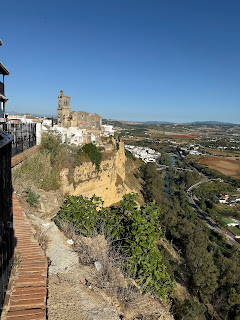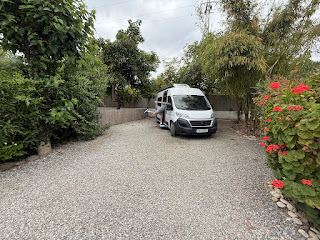 |
| Valencia Amphitheater |
Tarragona
Driving from Girona to Tarragona signs on the highway tell us in English "Flat tire? Don't trust strangers." Another warned us to beware of fake accidents. We consider ourselves forewarned.
Our photos here
Arrival at Camping Las Palmas in Tarragona is a pleasant surprise - sunny, warm weather; two restaurants and huge. We get a spot with an ocean view, just one space away from the beach for just over $25 per night. Dermot enjoyed watching the El Classico, Barcelona vs Reál Madrid game, which was being aired on a big screen in a courtyard with plenty of space for the many enthusiastic Barcelona fans. Meanwhile, I spend over an hour on a Whatsapp Mother's day call with my "kids." The camp’s restaurant caps the day off perfectly with a bass dinner for two as we gaze at the waves.

All the museum and archeological sites are closed on Monday so we planned to just visit the Cathedral Tarragona and roam around a bit. The Cathedral was so much better than expected since it also contained an art museum and an excellent series of excavated glimpses into the deep past including ancient Roman foundations, walls and a well; medieval additions and a pretty cloister. This was a real standout cathedral! The art was very enjoyable as there were many exceptional pieces. I got a kick out of a depiction of baby Jesus being a handful and clearly annoying Mary. Another baby Jesus had blond hair, a homely face but an inexplicably jacked physique.

Our choice of Mom and Pop place for lunch reminded us never to go where prices aren’t posted since “tourist rates” will be applied. We strolled the old town including the Jewish quarter then headed for a glimpse of the Roman sites. Turns out, this city has often preserved sections of its ancient Roman past and sometimes built on top of it through Visigoth and Medieval times. We got great views from the outside of many historical sites then made the mistake of taking a tourist train which drove us all over but provided no commentary.
The following day we visited the Amphitheatre, Roman Circus, Provincial Forum Praetorium, and the walls. For anyone who enjoys history, there’s nothing like being surrounded by it in a place like this with so many layers and interesting elements. Multiple audiovisual presentations attempted to give you the perspective of just how big and grand the Roman city of Tarraco was by showing overlays with present landscapes. We were really impressed.
We ate a delicious lunch at an Indian restaurant. Touristing is thirsty work so in the late afternoon we found a tiny cafe nearly bursting with locals and enjoyed their special of two drinks and tapas for 11 euros. It’s often hard to find parking for our campervan but here we got safe parking in a lot just outside the city walls for only €1 for the whole day. Shocking!
Valencia
Valencia Camper Park is conveniently located five minutes walks from the metro but lacks charm - it’s just gravel with bushes and small trees that dropped some fruits that were crushed into the gravel. We couldn’t avoid tracking this sticky mess into the van. The normal men’s restrooms were under construction so Dermot suffered through some cold showers and times the waiting line was too long.
We spent the first night here researching the public transportation system, what we really wanted to see and how to see it. Once again we wished Rick Steves covered this area. We concentrated on the old town the first day. The trip via metro is a straight shot in but took nearly an hour.

We first hit the massive Mercado which hosts many vendors in an art deco style building. It’s always fun to visit these busy markets bursting with all manner of fresh produce, meats, and seafood. We choose our lunch from among the prepared salads - mine was a potato, seafood, olive and veggie with a pesto dressing, Dermot’s was tuna, beans, purple onions and veggies with olive oil - both were tasty. Our guide book recommended trying horchata which is a traditional drink in Valencia, made with “tiger nuts.” My own research found these aren’t actually nuts but the edible tubers of a locally grown sedge. There are ground and mixed with water, sugar, and cinnamon. Our guide book told us the best place to get it and a fartón (which is an iced donut in a baton shape) for dunking in the horchata. We found a bench seat in the market square to enjoy our picnic. The horchata was rich and creamy but too sweet which explained why they also offered one without sugar.
The Set Espai d’Art in the plaza adjoining the Cathedral is the place to get handmade art as well as souvenirs.
The Cathedral’s audio guide was very well done and explained the vast history, archeological findings below ground level, reliquaries, treasure and the art. One of Goya’s paintings is here - complete with demons and blood spraying from a cross. It also boasts the true holy grail - according to their research.
Finnegan’s Irish pub gave us just the rest we needed. We wandered across the Puente de la Trinidad and took in the view of the Jardin del Turia. We only later learned there’s a whole archeological site below that we missed. The nearby Torres de Serranos was an impressive sight to behold. As we approached our chosen dinner spot, we were both intimidated by how upscale it looked. We’d arrived much earlier than Spaniards like to eat so we were given a table without having made a reservation. We both relished our meals of fish and veggies.
The following day we headed for the extensive modern architecture of the arts and sciences center. We took a tour of the 15 story Les Arts building which was built to resemble a Spartan helmet and clad in a mosaic of ceramic tiles in white and blue. I lost count of the performance spaces housed within it - each with acoustics designed to fit the type of performance - from opera, concerts, plays, and student productions. The seats were designed to ensure the acoustics would be the same no matter how many people attended. Each seat back in the largest space (primarily for opera) included a small screen on which a person could select to view subtitles in their preferred language. Genius!
There are multiple other impressive modern buildings nearby including a science center, IMAX cinema, aquarium, exhibition space, and the most lovely parking garage all flanked by a park.
Dénia
Feeling the need for a bit of relaxation, we picked Camping Los Pinos, Las Rotes with its location close to the sea but outside of the city and much more comfortable facilities. This city is on the Costa Blanca - known for its fantastic year round weather and beaches. Dermot read that about half the population is from France, Italy, Britain.
The paved board walk along the rocky beach made for nice walks with beautiful scenery but we never even made it in to see the castle in the heart of the city. Instead we did laundry and yoga at our campsite; ate meals from our tiny fridge and planned our next stop.
























